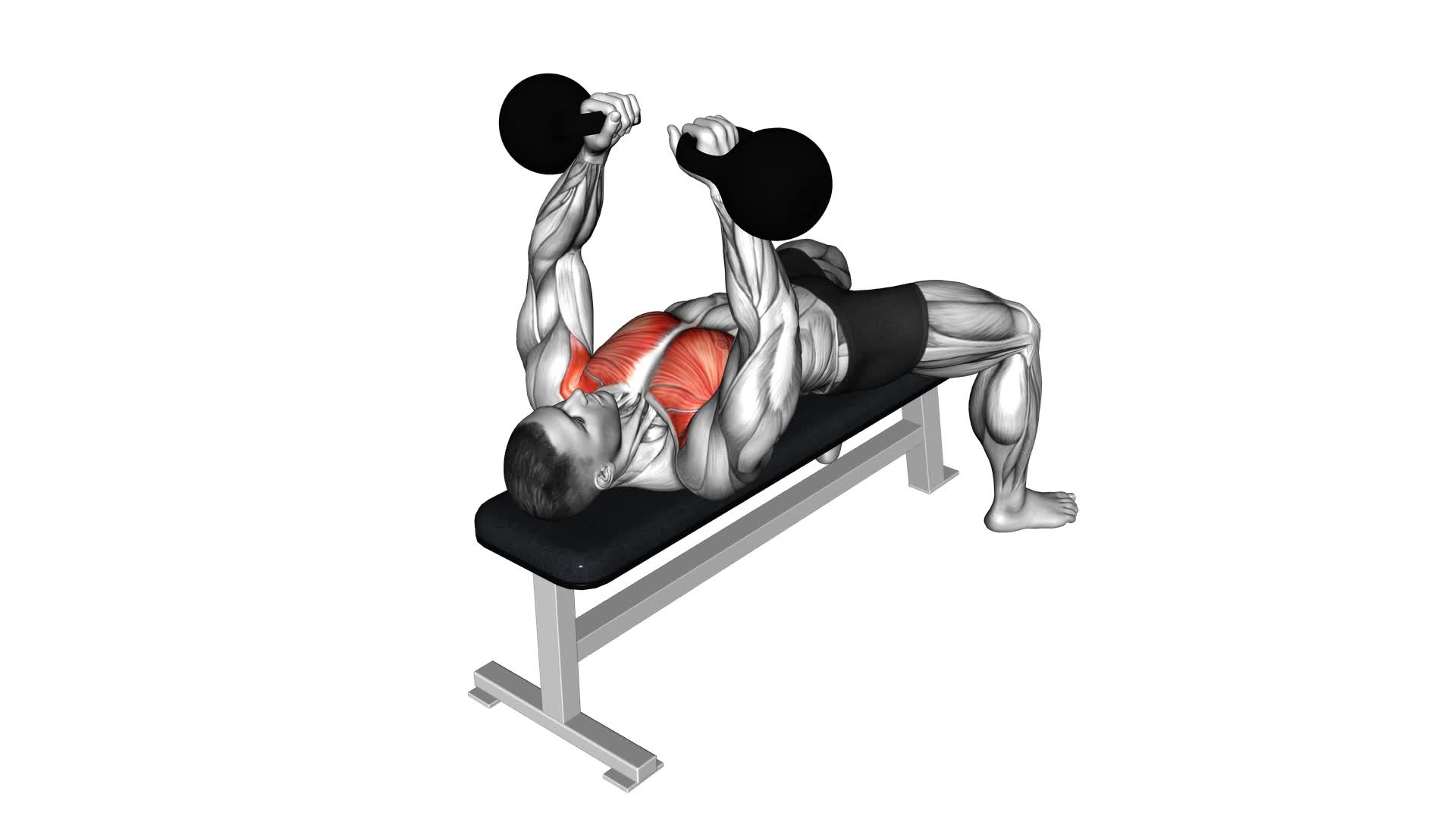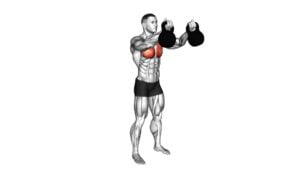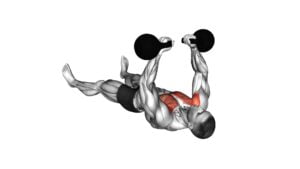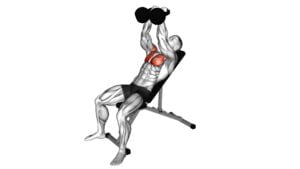Kettlebell Fly (male) – Video Exercise Guide & Tips

Get ready to take your workout to the next level with the Kettlebell Fly! In this video exercise guide, we'll show you the proper form and technique to maximize your results.
Watch This Exercise Video
Targeting your muscles in a whole new way, this exercise offers a multitude of benefits. Whether you're a beginner or an experienced lifter, we've got you covered with variations and progressions to suit your fitness level.
Avoid common mistakes and amp up your routine with our sample Kettlebell Fly workout.
Let's get started!
Key Takeaways
- The kettlebell fly offers a multitude of benefits and targets different muscle groups.
- Proper form and technique, including core engagement and maintaining a neutral spine, are crucial for performing the exercise effectively.
- Core engagement is important for stabilizing the spine and pelvis, improving overall strength and stability, and maximizing efficiency of movements.
- To avoid back strain, it is important to maintain proper form, engage core muscles, and avoid rounding or excessive arching of the back.
Benefits of the Kettlebell Fly
You can experience significant strength gains through the regular practice of the Kettlebell Fly. This exercise offers various variations that target different muscle groups and enhance overall core engagement. By incorporating kettlebell fly variations into your workout routine, you can reap numerous benefits.
One of the primary advantages of the kettlebell fly is its ability to strengthen your chest muscles. As you perform the exercise, your pectoralis major and minor muscles are engaged, leading to increased upper body strength. Additionally, the kettlebell fly activates your shoulder muscles, such as the deltoids, helping to improve their stability and functionality.
Another benefit of the kettlebell fly is its impact on core engagement. This exercise requires you to stabilize your core muscles throughout the movement, which contributes to better overall core strength and stability. By strengthening your core, you can improve your posture, enhance your balance, and reduce the risk of injury.
Proper Form and Technique
To perform the kettlebell fly exercise with proper form and technique, there are a few key points to keep in mind.
First, it's important to engage your core throughout the movement to maintain stability and prevent any strain on your back.
Additionally, make sure to avoid arching your back and instead focus on keeping a neutral spine.
Lastly, pay attention to your grip positioning on the kettlebell, ensuring a secure and comfortable hold to maximize your performance.
Core Engagement Importance
Maintaining proper core engagement is crucial for executing the kettlebell fly exercise with optimal form and technique. The importance of stability can't be overstated when performing this exercise. Engaging your core muscles helps to stabilize your spine and pelvis, allowing for a more controlled movement and reducing the risk of injury.
Additionally, by engaging your core, you're incorporating full body engagement, which leads to several benefits. It helps to improve overall body strength and stability, enhances balance and coordination, and increases the effectiveness of the exercise. Moreover, proper core engagement helps to transfer power from your lower body to your upper body, maximizing the efficiency of your movements.
Therefore, it's essential to focus on maintaining core engagement throughout the kettlebell fly exercise to ensure proper form and technique.
Avoiding Back Strain
To prevent back strain, focus on maintaining proper form and technique while performing the kettlebell fly exercise. This is essential for preventing injuries and strengthening the lower back.
When executing the kettlebell fly, it's crucial to engage your core muscles and keep your back straight throughout the movement. Avoid rounding your back or arching it excessively, as this can put unnecessary strain on your spine.
Additionally, ensure that you're using an appropriate weight for your fitness level and gradually increase it as you become stronger. Remember to keep a controlled and smooth motion while lifting and lowering the kettlebell, avoiding any jerking or sudden movements.
Proper Grip Positioning
Ensure a secure grip on the kettlebell handle to maintain proper form and technique during the kettlebell fly exercise. Your grip strength plays a crucial role in effectively executing this exercise.
When grabbing the handle, make sure your hands are positioned at the sides, slightly wider than shoulder-width apart. This wider grip allows for better engagement of the muscles in your chest and shoulders.
Additionally, ensure that your palms are facing inward towards your body throughout the movement. This hand placement promotes stability and control during the exercise, reducing the risk of injury.
Targeted Muscles
To effectively target your muscles during a kettlebell fly exercise, it's important to focus on:
- Muscle activation techniques
- Proper form and technique
- The benefits of targeting specific muscles
Muscle Activation Techniques
Activate your targeted muscles with these muscle activation techniques.
To maximize the effectiveness of your kettlebell fly exercise, incorporate the following muscle activation exercises and drills into your routine:
- Pre-Activation Techniques:
- Perform bodyweight exercises such as push-ups or planks to activate your chest, shoulders, and triceps before starting the kettlebell fly.
- Engage your core muscles by performing exercises like Russian twists or flutter kicks.
- Isolation Techniques:
- Use resistance bands to isolate and activate your chest muscles by performing chest flies or resisted push-ups.
- Incorporate shoulder activation exercises, such as lateral raises or shoulder presses, to engage your deltoids.
By implementing these muscle activation techniques, you can ensure that your targeted muscles are fully engaged and prepared for the kettlebell fly exercise.
Now, let's dive into the next section to learn about the proper form and technique for performing this exercise.
Proper Form and Technique
To properly engage your targeted muscles during the kettlebell fly exercise, position yourself in a stable stance and hold the kettlebell with both hands at chest level. It's essential to maintain proper form and technique to maximize the effectiveness of this exercise.
One common misconception is that the kettlebell fly is solely an upper body exercise. However, it also engages your core and lower body muscles for stabilization.
Another important aspect to consider is the importance of breathing. Exhale as you push the kettlebell away from your body, and inhale as you bring it back to the starting position. This coordinated breathing pattern helps to stabilize your core and enhance the effectiveness of the exercise.
Benefits of Targeted Muscles
When targeting specific muscles with the kettlebell fly exercise, it's important to understand the benefits they provide for overall strength and stability. Here are the muscle groups targeted and the muscle activation techniques:
- Muscle Groups Targeted:
- Pectoralis Major: The primary muscle worked during the kettlebell fly exercise is the pectoralis major, which is responsible for chest development and upper body strength.
- Deltoids: The deltoids, or shoulder muscles, are also activated during this exercise, helping to stabilize the shoulder joint and enhance overall shoulder strength.
- Muscle Activation Techniques:
- Isolation: The kettlebell fly exercise allows for targeted activation of the pectoralis major and deltoids, ensuring maximum muscle engagement and development.
- Stabilization: By performing this exercise with proper form and control, it helps strengthen the stabilizing muscles of the shoulder joint, leading to improved stability and reduced risk of injury.
Incorporating the kettlebell fly exercise into your workout routine can effectively target these muscle groups and enhance your overall strength and stability.
Variations and Progressions
To progress in the kettlebell fly exercise, increase the weight of your kettlebell to challenge your muscles further. This will help you to continuously improve your strength and endurance.
There are also several variations and progressions you can incorporate into your kettlebell fly routine to keep it challenging and prevent plateauing.
One variation is the single-arm kettlebell fly. Instead of using both arms simultaneously, you'll perform the exercise using only one arm at a time. This requires greater stability and control, as well as increased engagement of your core muscles.
Another variation is the kneeling kettlebell fly. Instead of standing, you'll kneel on the ground with one knee and place your opposite hand on a bench or chair for support. This variation increases the activation of your stabilizer muscles and places more emphasis on your chest muscles.
To further progress, you can try performing the kettlebell fly on an unstable surface, such as a Bosu ball or balance board. This adds an extra challenge to your stability and forces your muscles to work harder to maintain balance.
Remember to start with lighter weights and gradually increase the weight as you become stronger and more comfortable with the exercise. Always prioritize proper form and technique to avoid injury and get the most out of your kettlebell fly workouts.
Common Mistakes to Avoid
To avoid common mistakes and maximize the effectiveness of your kettlebell fly exercise, focus on maintaining proper form and technique throughout the movement. Here are some common mistakes to avoid and tips for injury prevention:
- Using too heavy of a weight: It's important to choose a weight that allows you to maintain control and proper form throughout the exercise. Using a weight that's too heavy can lead to poor technique and increase the risk of injury.
- Arching your back: One common mistake is arching the back during the movement. This not only puts unnecessary strain on the lower back but also takes away from the targeted muscles. Keep your back straight and engage your core to maintain stability.
- Flaring your elbows: When performing the kettlebell fly, avoid flaring your elbows out to the sides. This can strain the shoulder joints and lead to discomfort or injury. Keep your elbows slightly bent and in line with your shoulders throughout the exercise.
- Rushing the movement: Another mistake to avoid is rushing through the exercise. Take your time and focus on the muscles you're targeting. Slow and controlled movements will help you maintain proper form and maximize the benefits of the exercise.
By avoiding these common mistakes and focusing on proper form, you can prevent injuries and get the most out of your kettlebell fly exercise.
Now, let's move on to the next section about a sample kettlebell fly workout routine.
Sample Kettlebell Fly Workout Routine
For an effective kettlebell fly workout routine, incorporate a variety of exercises that target your chest and upper body muscles. The kettlebell fly is a great exercise for building strength and muscle in your chest, shoulders, and triceps. To modify the kettlebell fly, you can use a lighter weight or adjust the range of motion to suit your fitness level.
Incorporating the kettlebell fly into a full body workout has many benefits. It not only works your chest and upper body muscles, but also engages your core, glutes, and legs for stability. This exercise helps improve your upper body strength and posture, and can even enhance your performance in other exercises and sports.
A sample kettlebell fly workout routine could include exercises like push-ups, dumbbell chest presses, and kettlebell swings. Start with a warm-up to prepare your muscles, then perform 3 sets of 10-12 reps of kettlebell flies, followed by 2 sets of 10-12 reps of each of the other exercises. Rest for 30-60 seconds between sets to allow for recovery.
Remember to use proper form and technique throughout your workout to avoid injury. Start with a weight that challenges you but allows you to maintain good form. As you become stronger, you can gradually increase the weight to continue progressing.
Frequently Asked Questions
What Is the Recommended Weight for a Kettlebell Fly Exercise?
For the kettlebell fly exercise, the recommended weight depends on your fitness level and goals. Using a weight that challenges you but allows for proper form is key.
The benefits of kettlebell fly include strengthening your chest, shoulders, and arms, improving posture, and enhancing core stability.
It's important to start with a lighter weight and gradually increase as you become stronger. Always consult with a professional trainer for personalized recommendations.
How Often Should I Incorporate Kettlebell Fly Exercises Into My Workout Routine?
To effectively incorporate kettlebell fly exercises into your workout routine, it's important to consider the benefits they provide for your chest muscles. By regularly including these exercises, you can strengthen and tone your chest, leading to improved upper body strength and posture.
Aim to perform kettlebell fly exercises at least 2-3 times a week, allowing for proper recovery between sessions. Remember to start with a weight that challenges you, but still allows for proper form and technique.
Are There Any Specific Warm-Up Exercises I Should Do Before Performing Kettlebell Fly?
Before performing the kettlebell fly exercise, it's important to incorporate specific warm-up exercises into your routine. This helps prepare your muscles and joints for the movements involved in the flys. A proper warm-up routine can increase blood flow, improve flexibility, and reduce the risk of injury.
Additionally, the kettlebell fly exercise offers numerous benefits. It targets the chest, shoulders, and triceps, while also engaging the core and promoting overall upper body strength.
Can Kettlebell Fly Exercises Help in Improving Posture?
Kettlebell fly exercises can definitely help improve your posture. This exercise targets your upper back and shoulders, which are important for maintaining good posture. By strengthening these muscles, you can prevent slouching and rounding of the shoulders.
The kettlebell fly also works your chest and core, providing overall strength and muscle toning. To maximize effectiveness, make sure to maintain proper form by keeping your back straight and engaging your core throughout the movement.
Are There Any Modifications or Alternatives for Individuals With Lower Back Pain or Injuries?
If you have lower back pain or injuries, there are modifications and alternative exercises you can try.
It's important to prioritize your safety and avoid aggravating your condition.
Speak with a fitness professional or physical therapist who can suggest modifications for the kettlebell fly exercise or alternative exercises that will be safer for your back.
Remember to listen to your body and only do exercises that feel comfortable and pain-free.
Conclusion
In conclusion, the kettlebell fly is a highly effective exercise for building strength and targeting the chest, shoulders, and triceps.
By using proper form and technique, you can maximize the benefits of this exercise while avoiding common mistakes.
With variations and progressions, you can continually challenge yourself and see progress over time.
Incorporating the kettlebell fly into your workout routine can help you achieve a well-rounded upper body workout.

Author
Years ago, the spark of my life’s passion ignited in my mind the moment I stepped into the local gym for the first time. The inaugural bead of perspiration, the initial endeavor, the very first surge of endorphins, and a sense of pride that washed over me post-workout marked the beginning of my deep-seated interest in strength sports, fitness, and sports nutrition. This very curiosity blossomed rapidly into a profound fascination, propelling me to earn a Master’s degree in Physical Education from the Academy of Physical Education in Krakow, followed by a Sports Manager diploma from the Jagiellonian University. My journey of growth led me to gain more specialized qualifications, such as being a certified personal trainer with a focus on sports dietetics, a lifeguard, and an instructor for wellness and corrective gymnastics. Theoretical knowledge paired seamlessly with practical experience, reinforcing my belief that the transformation of individuals under my guidance was also a reflection of my personal growth. This belief holds true even today. Each day, I strive to push the boundaries and explore new realms. These realms gently elevate me to greater heights. The unique combination of passion for my field and the continuous quest for growth fuels my drive to break new ground.



